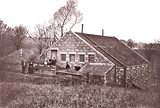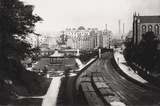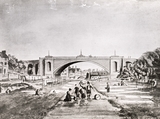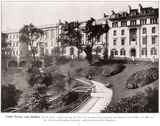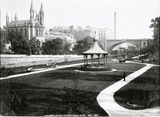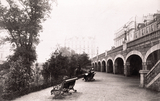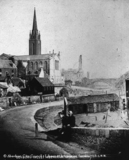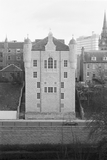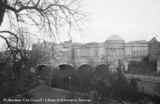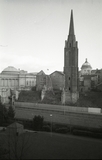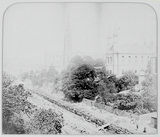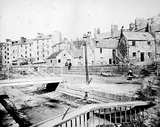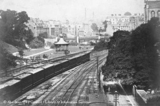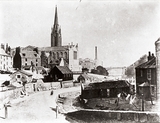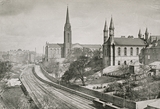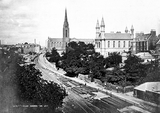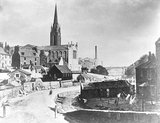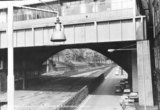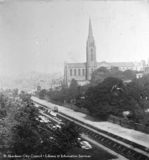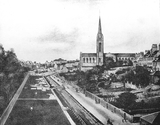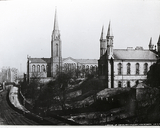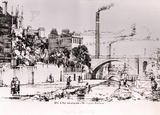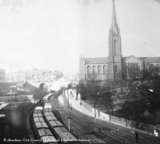|
Quick Search
|
Search Results
You searched for: Subject matches "Denburn" or its children
110 items
items as
Glenburnie Distillery
5 Glenburnie Distillery stood near to the Denburn, about 100 yards east of the dam in Rubislaw Den, and was reached from Spademill Road. It was in operation until 1857 when the buildings were taken over by Mr G. W. Wilson for photographic printing until 1875. They were later demolished to make way for the construction of Forest Road. This photograph dates from the 1860s. Denburn Valley
48 The Denburn Valley Railway, shown here on the right, was constructed in 1865-67. It runs from the Joint Station at Guild Street north through the valley. To the left of the railway lines is Union Terrace Gardens which were opened to the public on 11th August 1879.
The closeness of the railway led to the gardens being nicknamed the "Trainie Park". The bandstand shown here in the centre of the park was removed in around 1931.
The iron footbridge visible in this image allowed access over the Denburn and railway between Rosemount and the city centre. It was replaced by the Denburn Viaduct which was built in 1886, at the same time as Rosemount Viaduct, by engineer William Boulton. Part of the footbridge was moved and reassembled in the newly created Duthie Park.
This image also predates the construction of significant buildings on Rosemount Viaduct such as the Public Library and the Free South Church (both dating from 1892). In the background, on the left of the image can be seen the houses at the foot of a then longer Skene Terrace. These are on the site later occupied by the library and church.
To the right of those houses are Black's Buildings. Local historian Diane Morgan explains that they were "a small curving crescent of tall tenements, four and five storeys high, [and] sat below the Royal Infirmary, Woolmanhill, just west of the apex of the Woolmanhill triangle. (...) The houses were built in stages between 1789 and 1830, by the wine merchant James Black." (Lost Aberdeen: Aberdeen's lost architectural heritage, 2004). The tenements were pulled down in 1957.
Woolmanhill Hospital, designed by Archibald Simpson and built 1832-1838, can be seen in the background. Chimneys of Broadford Works, the textile factory located between Ann Street, Maberly Street and Hutcheon Street, are also visible. Union Bridge
58 The Denburn looking southward towards and beyond Union Bridge, with the old Bow Brig in the distance and the houses adjacent. The Bow Brig featured largely in the social life of the inhabitants of the area. Note the bleaching green on the right of the print. Illustration taken from a plate drawn by Sir John Carr, 1807 Union Terrace Gardens
85 Union Terrace showing Union Terrace Gardens. The gardens were laid out between 1891 and 1893. Union Terrace Gardens
89 Union Terrace Gardens looking towards the Union Bridge. The spires of Belmont Congregational Church are on the left. The gardens were laid out in 1891-3. The chimney belonged to Hadden's textile factory in the Green. Union Terrace Gardens
116 This photograph was taken from the Union Terrace Gardens, in the city centre. The building in the background is the Palace Hotel in Union Street. The building burnt on the 31st October 1941 and was subsequently demolished after the WW2, which give us a solid lead to date the photograph. The building on the corner is the Monkey house. Belmont Cinema
473 The rear elevation on the Denburn of the Belmont Cinema. The entrance is on Belmont Street. c.1999. Union Terrace Gardens
474 Union Terrace Gardens looking towards Rosemount Viaduct, Aberdeen. c.1999. Denburn Valley
481 The Denburn, Aberdeen, in around 1865. The Triple Kirks are in the centre of the photograph with the Belmont Congregational Church in the foreground.
In 1850, the Aberdeen Railway Co. which later amalgamated with the Scottish Midland Junction Co. to form the Scottish North Eastern Railway, brought the line from the south into the city. In 1864, after great debate, the Denburn Valley Junction Railway Scheme was adopted - forming a direct link between Kittybrewster and Guild Street.
This photograph shows the commencement of the work. The new Joint Station opened in 1867 The Denburn, Aberdeen
483 The Denburn, Aberdeen with Union Terrace Gardens complete with bandstand on the left and the railway tracks leading into the Joint Station in the foreground. Denburn
493 The Denburn Valley and Mutton Brae prior to the construction of Rosemount Viaduct. The Triple Kirks are visible in the middle of the image and Union Bridge can seen in the background. The Denburn Valley
498 The Denburn, Aberdeen. The Triple Kirks are in the distance with the spires of St. Nicholas Congregational Church in the foreground. In 1850, the Aberdeen Railway Co. which later amalgamated with the Scottish Midland Junction Co. to form the Scottish North Eastern Railway, brought the line from the south into the city. In 1864, after great debate, the Denburn Valley Junction Railway Scheme was adopted - forming a direct link between Kittybrewster and Guild Street. This photograph shows the commencement of the work. The new Joint Station opened in 1867. The Denburn, Aberdeen
500 The Denburn. In 1850, the Aberdeen Railway Co. which later amalgamated with the Scottish Midland Junction Co. to form the Scottish North Eastern Railway, brought the line from the south into the city. In 1864, after great debate, the Denburn Valley Junction Railway Scheme was adopted - forming a direct link between Kittybrewster and Guild Street. This photograph shows the commencement of the work. The new Joint Station opened in 1867 The Denburn
558 The Denburn showing the railway lines and the extension to the Union Bridge which now carries shop units. The Denburn Valley, showing the Triple Kirks
581 The Denburn Valley, looking North, showing the Triple Kirks. These churches, opened in 1843/44, were designed by Archibald Simpson for three Free Church congregations. Prior to the opening of the Denburn Valley Junction Railway in 1867 the Denburn ran as an open burn. The adjacent grassy area was used as bleaching greens for sheets which had been washed in the burn. Triple Kirks, Denburn
668 The Triple Kirks were built to the design of Archibald Simpson to house three separate Free Church congregations in 1843/44.
Due to lack of funds, second-hand building materials were used (reputedly the down takings from the old Dee Village), and the spire, which was modelled on that of the Katherinenkirche, Magdeburg, is of 18th century Ferryhill brick.
The church in the foreground was designed by James Souttar and opened in 1865 as Belmont Congregational Church, becoming known as St. Nicholas Congregational in 1910. Its final service was held in 1995. The Denburn Valley, showing Union Bridge
691 The Denburn Valley, showing Union Bridge. The chimney belonged to Hadden's textile mill in the Green. Union Terrace Gardens and the Denburn
692 This view taken about 1884 shows the railway line which runs north from the Joint Station through the Denburn Valley.
The Denburn ran as an open burn throughout this area with bleaching greens next to it, until the railway was constructed in 1865-7, when the burn was covered over and the greens removed.
In the late 1870's, Union Terrace Gardens was laid out next to the railway, and it was sometimes referred to as the 'Trainie Park'. The bandstand has long since been removed.
The iron footbridge on granite supports which allowed access across the gardens from Schoolhill to Union Terrace was replaced by Schoolhill Viaduct in 1886/7. This created a site for His Majesty's Theatre, South UF Church, and Aberdeen Public Library. The Denburn Valley
699 The Denburn with the railway track passing Union Terrace Gardens on the left. The spire of the Triple Kirks is seen on the right, and the Royal Infirmary, Woolmanhill buildings are in the background. |



